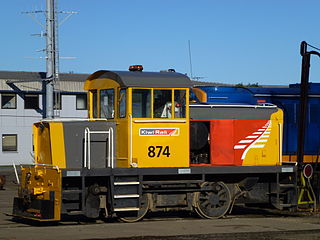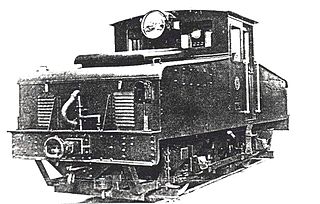
A locomotive or engine is a rail transport vehicle that provides the motive power for a train. If a locomotive is capable of carrying a payload, it is usually rather referred to as a multiple unit, motor coach, railcar or power car;

A switcher locomotive, shunter locomotive, or shifter locomotive is a locomotive used for maneuvering railway vehicles over short distances. Switchers do not usually move trains over long distances, instead they typically assemble trains in order for another locomotive to take over. Switchers often operate in a railyard or make short transfer runs. They may serve as the primary motive power on short branch lines or switching and terminal railroads.

An electric locomotive is a locomotive powered by electricity from overhead lines, a third rail or on-board energy storage such as a battery or a supercapacitor. Locomotives with on-board fuelled prime movers, such as diesel engines or gas turbines, are classed as diesel-electric or gas turbine-electric and not as electric locomotives, because the electric generator/motor combination serves only as a power transmission system.

The British Rail Class 08 is a class of diesel-electric shunting locomotives built by British Railways (BR). As the standard BR general-purpose diesel shunter, the class became a familiar sight at major stations and freight yards. Since their introduction in 1952, however, the nature of rail traffic in Britain has changed considerably. Freight trains are now mostly fixed rakes of wagons, and passenger trains are mostly multiple units or have Driving Van Trailers, neither requiring the attention of a shunting locomotive. Consequently, a large proportion of the class has been withdrawn from mainline use and stored, scrapped, exported or sold to industrial or heritage railways.

The British Railways Class D3/7 is a class of 0-6-0 diesel electric shunting locomotives built as LMS Nos. 7080–7119. The class were built from May 1939 through to July 1942 by the London, Midland and Scottish Railway at their Derby Works using a diesel electric transmission supplied by English Electric.

An electro-diesel locomotive is a type of locomotive that can be powered either from an electricity supply or by using the onboard diesel engine. For the most part, these locomotives are built to serve regional, niche markets with a very specific purpose.

Prima is a family of railway diesel and electric locomotives built by Alstom. Manufacture of the type commenced in the late 1990s. By 2008, Alstom had reportedly sold 1,750 Prima locomotives. The second generation Prima II was launched in 2009. The Prima H3 diesel/battery hybrid locomotive was launched in 2013.

London Underground battery-electric locomotives are battery locomotives used for hauling engineers' trains on the London Underground network where they can operate when the electric traction current is switched off. The first two locomotives were built in 1905 for the construction of the Great Northern, Piccadilly and Brompton Railway, and their success prompted the District Railway to buy two more in 1909, which were the only ones built to the loading gauge of the subsurface lines. Following this, a number of battery vehicles were built by converting redundant motor cars, with the batteries placed in the unused passenger compartment. One exception to this was made by the City and South London Railway, who used a trailer car to hold the batteries, and wired them to a separate locomotive.
Locomotives of New Zealand is a complete list of all locomotive classes that operate or have operated in New Zealand's railway network. It does not include locomotives used on bush tramways.

The New Zealand EB class locomotive was a class of five battery electric locomotives built to perform shunting duties at the workshops of New Zealand's national rail network.

The FS E.645 and E.646 are two classes of similar electric locomotives used on Italian railways. They were introduced during the 1950s and they were retired in 2009.

Steeplecab is railroad terminology for a style or design of electric locomotive; the term is rarely if ever used for other forms of power. The name originated in North America and has been used in Britain as well.

The New Zealand TR class locomotive is a type of diesel shunting locomotives built by many different manufacturers. Defined as "shunting tractors" or "rail tractors" by KiwiRail and its predecessors, they are classified "TR" for tractor as a result. Many of these locomotives have been withdrawn, but some are still in service. The first locomotive of this class was built by NZR in 1924. The most powerful were Japanese-built Hitachi TRs, with 138 kW Cummins engines.

The E.464 is a class of Italian railways electric locomotives. They were introduced in the course of the 1990s for hauling light trains, especially for commuter service. They were acquired by FS Trenitalia to replace the old E.424 and E.646, dating from the 1940s and 1950s. The class was originally designed by ABB Trazione, later ADTranz, and produced in the Italian plant of Vado Ligure.

The Western Australian Government Railways operated many unique steam, diesel and electric locomotive classes. Often suffering from lack of available funds the WAGR locomotive fleet often consisted of locomotives far older than their expected operational life. Only one electric locomotive was operated by the government during the WAGR years.

A Kleinlokomotive or Kleinlok is a German locomotive of small size and low power for light shunting duties at railway stations and on industrial railways. Most are powered by diesel engines, but Kleinloks with steam, petrol, or electric engines were also produced.

The South African Railways Class ES1 of 1924 was an electric locomotive.

The FS Class E.430 locomotives, initially classed as RA 34, were three-phase alternating current electric locomotives of the Italian railways. They were built for Ferrovia della Valtellina by Ganz and MÁVAG in 1901 and had a power output of 440 kW and a haulage capacity of 300 tons. One locomotive is preserved.

FS Class E.220 was a two-axle electric locomotive, powered by a third rail, built for operation on the Varese line of the Italian Rete Mediterranea and registered as RM 02. It was acquired by the Italian State Railways in 1918 and re-registered as 220.01. It remained a unique example.
The British Rail Class 18 is a class of hybrid locomotives designed and built by the British railway locomotive manufacturer Clayton Equipment Company in Burton upon Trent, Staffordshire. It has also been referred to as the CBD90 Hybrid+ by Clayton and private railway customers.


















